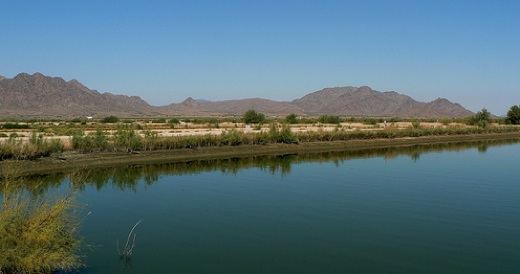When I hear shrimp farm in the Arizona desert my first thoughts are not about biofuels and sustainability. But to hear Gary Wood, owner of Desert Sweet Shrimp near the state’s Gila Bend, tell it, the innovations coming out of his shrimp farm could be the next big idea to hit the biofuel movement.

While the Desert Sweet Shrimp website design is a decade behind, their innovative thinking about sustainability and biofuel is a decade ahead. Their main business is raising exceptional shrimp for high end restaurants and grocery stores around the country, and doing so sustainably. The farm prides itself on using no antibiotics, herbicides, or pesticides in raising the shrimp and reuses all of the mineral-rich water as irrigation for surrounding farmland. On their About page they call it environmental synergy.
Wood wants to utilize his farming experience to grow algae for fuel. The system Wood and others are developing is complicated, but it utilizes existing technologies in new ways. As Wood says, “All this technology has been around for a long time, we are just putting it together in a different way. It all kind of works together.”

Step 1 involves “gasification,†which Wood describes as an oven that heats up farm waste like straw and wood chips. The oven creates hydrogen and carbon monoxide that are pumped into another unit and used to generate electricity, and the end emissions are pumped into the algae ponds to help the algae grow faster. The burned biomass in the oven, called “biochar,†becomes fertilizer. Later, the algae will be pressed for oil and used as fuel, much in the way that palm oil is used.
The algae for fuel concept has a strong advocate in Arizona State University Professor Mark Edwards, whose book Green Algae Strategy: End Oil Imports and Engineer Sustainable Food and Fuel outlines the case for how and why algae is a biofuel of the future. His book has even won accolades from conservative writers.
Experts caution that there may be too many steps where something can go wrong or that harvesting oil from algae will never be economically feasible- right now it costs around $20 for a gallon of fuel.
Wood has a range of ideas about how to offset the cost of producing the fuel, though. The system that he has worked out creates fertilizers and electricity, all of which can be sold to offset the cost of fuel production. He also envisions many smaller versions of his operation across Arizona, which would bring down the cost of equipment.
In the search for biofuels, innovative thinking is and it could be that one answer is a floating green slime on top of shrimp farm waters in the middle of an Arizona desert.

You must be logged in to post a comment.